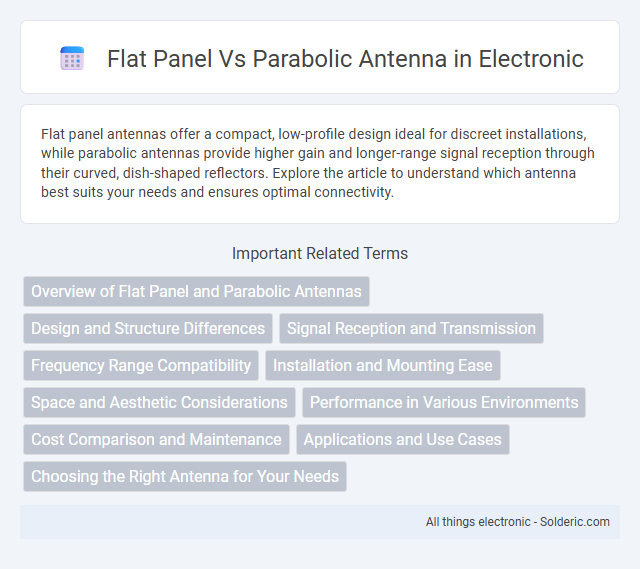Flat panel antennas offer a compact, low-profile design ideal for discreet installations, while parabolic antennas provide higher gain and longer-range signal reception through their curved, dish-shaped reflectors. Explore the article to understand which antenna best suits your needs and ensures optimal connectivity.
Comparison Table
| Feature | Flat Panel Antenna | Parabolic Antenna |
|---|---|---|
| Design | Compact, flat surface | Concave, dish-shaped |
| Size | Smaller, lightweight | Larger, heavier |
| Gain | Moderate gain (20-28 dBi) | High gain (30-45 dBi) |
| Beamwidth | Wider beamwidth | Narrow, focused beam |
| Installation | Easy, low profile | Requires more space, precise alignment |
| Use Case | Urban, mobile, small cells | Long-distance communication, satellite |
| Cost | Generally lower cost | Higher cost due to design and materials |
| Durability | Less affected by wind, durable plastic | More vulnerable to wind, metal dish |
Overview of Flat Panel and Parabolic Antennas
Flat panel antennas utilize a compact, slim design with integrated phased array technology to provide directional signal transmission and reception, making them ideal for modern wireless communication systems requiring low profile installations. Parabolic antennas feature a large, curved reflector dish that focuses radio waves onto a single feed point, delivering high gain and long-distance signal range commonly used in satellite and radar applications. Your choice between the two depends on the need for portability, installation space, signal range, and gain performance.
Design and Structure Differences
Flat panel antennas utilize a planar, compact design with multiple small antenna elements arranged in a grid to provide directional signal reception, making them lightweight and easy to install. Parabolic antennas feature a curved, dish-shaped reflector that focuses incoming signals onto a central feed horn, offering higher gain and better signal concentration but requiring more space and precise alignment. The flat panel's slim profile contrasts with the parabolic's three-dimensional curvature, influencing their respective performance and application scenarios.
Signal Reception and Transmission
Flat panel antennas provide stable signal reception and transmission with a compact, low-profile design ideal for environments with limited space and short to medium range communication. Parabolic antennas excel in long-range, high-gain applications by focusing radio waves onto a single focal point for strong, directional signal reception and transmission, making them suitable for satellite and point-to-point communication links. The choice between flat panel and parabolic antennas ultimately depends on the required range, gain, and installation constraints of the communication system.
Frequency Range Compatibility
Flat panel antennas typically operate efficiently within the 2 GHz to 60 GHz frequency range, making them ideal for modern 5G networks and high-frequency satellite communications. Parabolic antennas offer broader frequency compatibility, commonly supporting 1 GHz to 30 GHz, which suits long-distance microwave links and deep space communication. The choice between flat panel and parabolic antennas depends on the specific application's frequency requirements and desired beamwidth precision.
Installation and Mounting Ease
Flat panel antennas offer straightforward installation with compact, lightweight designs that can be easily mounted on walls or poles, making them ideal for limited space and urban environments. Parabolic antennas require more precise alignment and sturdier mounting due to their larger size and focus on directional signal reception, which can complicate setup in confined areas. Your choice depends on the installation environment, with flat panels providing more flexibility and parabolic dishes delivering optimized directional performance.
Space and Aesthetic Considerations
Flat panel antennas offer a compact, low-profile design that seamlessly integrates into modern architectural spaces, preserving your property's aesthetic appeal without bulky protrusions. Parabolic antennas require more space due to their large, curved dishes and are often visually intrusive, making them less suitable for areas with limited room or strict design regulations. Choosing a flat panel antenna optimizes space utilization while maintaining a sleek, unobtrusive look.
Performance in Various Environments
Flat panel antennas deliver consistent signal quality in urban environments with obstacles due to their wide beamwidth and resistance to multipath interference. Parabolic antennas excel in open areas by providing higher gain and focused signals, maximizing long-distance communication in clear line-of-sight conditions. Your choice depends on whether you prioritize broad coverage and interference resilience or maximum signal strength for remote settings.
Cost Comparison and Maintenance
Flat panel antennas generally have lower upfront costs due to simpler design and mass production, while parabolic antennas tend to be more expensive because of their larger size and specialized materials. Maintenance expenses for flat panel antennas are typically lower, requiring minimal adjustments and cleaning, whereas parabolic antennas need regular precise alignment and more frequent upkeep to ensure optimal performance. Overall, flat panel solutions offer cost-effective installation and reduced maintenance overhead, making them suitable for budget-conscious projects.
Applications and Use Cases
Flat panel antennas excel in urban environments and on moving platforms such as vehicles or drones, offering compact designs ideal for 5G networks and satellite internet. Parabolic antennas provide high gain and narrow beamwidth, making them suitable for long-distance communication, radio telescopes, and point-to-point microwave links. In satellite ground stations, parabolic reflectors dominate due to superior signal focus, while flat panels are preferred for portable and multi-beam applications.
Choosing the Right Antenna for Your Needs
Flat panel antennas offer compact design and ease of installation, making them ideal for limited spaces and mobile applications. Parabolic antennas provide higher gain and better signal focus, suitable for long-distance communication and environments requiring strong, directional signals. Selecting the right antenna depends on factors such as available space, required range, signal strength, and specific use-case scenarios.
flat panel vs parabolic antenna Infographic

 solderic.com
solderic.com